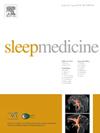Differential respiratory function response in paediatric spinal muscular atrophy types 2 and 3 treated with nusinersen over 3 years
IF 3.8
2区 医学
Q1 CLINICAL NEUROLOGY
引用次数: 0
Abstract
Aim
To establish whether the initial positive effect of nusinersen (NUS) on respiratory outcomes in the first year of treatment was maintained in children with Spinal Muscular Atrophy (SMA) type 2 and to further define the effect on children with type 3 treated over 3 years.
Methods
A prospective observational study of children with type 2 and 3 beginning NUS in Queensland, Australia between June 2018–December 2020 was undertaken. Investigations conducted included age-appropriate lung function and polysomnography. Lung function data for two-years preceding NUS initiation was retrospectively collected. Change in lung function/polysomnography was assessed using mixed effects linear regression.
Results
24 of 30 children with type 2 and 3 SMA (14 males; 2.6–15.8) were included (type 2 n = 12; type 3 n = 12). No child had respiratory-related admissions during the period of study. For type 2, annual decline in FVC z-score pre-treatment was −0.75 (95 % CI: 1.14, −0.39, p < 0.001), and for the first 3 years on NUS was −0.20 ([95 % CI: 0.33, −0.06, p = 0.01] difference p = 0.008). For type 3 minimal change was seen: pre-NUS and post FVC z-scores −0.20 (95 % CI: 1.00, 0.61 p = 0.05) and −0.46 (95 % CI: 0.88, −0.04 p = 0.40) respectively (difference p = 0.46). Mean change in total apnoea-hypopnoea indices (total AHI) in type 2 tended to reduce −1.75 (95 % CI: 4.95–0.9, p = 0.24); type 3 appeared to remain stable (−0.39 [95 % CI: 1.1–0.33, p = 0.28). One child with type 2 ceased NIV due to normalisation of total AHI and gas exchange.
Conclusion
Nusinersen lung function (FVC-z-scores) stability seen in the first year was maintained over 3 years and the total AHI tended to improve in type 2, but the long-term effects in type 3 are less clear.
小儿脊髓性肌萎缩2型和3型治疗3年以上呼吸功能反应的差异
目的探讨nusinersen (NUS)对2型脊髓性肌萎缩症(SMA)患儿治疗第一年呼吸功能的初始积极作用能否维持,并进一步确定3年治疗后对3型脊髓性肌萎缩症患儿的影响。方法对2018年6月至2020年12月在澳大利亚昆士兰州开始的2型和3型NUS儿童进行前瞻性观察研究。调查包括与年龄相适应的肺功能和多导睡眠图。回顾性收集NUS开始前两年的肺功能数据。使用混合效应线性回归评估肺功能/多导睡眠图的变化。结果30例2、3型SMA患儿中24例(男14例;纳入2.6-15.8例患者(2型n = 12;3型n = 12)。在研究期间,没有儿童因呼吸相关疾病入院。对于2型患者,FVC z-score预处理后的年降幅为- 0.75 (95% CI: 1.14, - 0.39, p <;0.001),在NUS治疗的前3年为- 0.20 ([95% CI: 0.33, - 0.06, p = 0.01]差异p = 0.008)。对于3型患者,变化最小:nus前和FVC后z-评分分别为- 0.20 (95% CI: 1.00, 0.61 p = 0.05)和- 0.46 (95% CI: 0.88, - 0.04 p = 0.40)(差异p = 0.46)。2型患者总呼吸暂停-低通气指数(total AHI)的平均变化趋向于降低- 1.75 (95% CI: 4.95 ~ 0.9, p = 0.24);3型似乎保持稳定(- 0.39 [95% CI: 1.1-0.33, p = 0.28])。1例2型患儿因总AHI和气体交换正常化而停止NIV。结论nusinersen肺功能(fvc -z评分)第一年的稳定性可维持3年以上,2型患者的总AHI有改善的趋势,但3型患者的长期影响尚不清楚。
本文章由计算机程序翻译,如有差异,请以英文原文为准。
求助全文
约1分钟内获得全文
求助全文
来源期刊

Sleep medicine
医学-临床神经学
CiteScore
8.40
自引率
6.20%
发文量
1060
审稿时长
49 days
期刊介绍:
Sleep Medicine aims to be a journal no one involved in clinical sleep medicine can do without.
A journal primarily focussing on the human aspects of sleep, integrating the various disciplines that are involved in sleep medicine: neurology, clinical neurophysiology, internal medicine (particularly pulmonology and cardiology), psychology, psychiatry, sleep technology, pediatrics, neurosurgery, otorhinolaryngology, and dentistry.
The journal publishes the following types of articles: Reviews (also intended as a way to bridge the gap between basic sleep research and clinical relevance); Original Research Articles; Full-length articles; Brief communications; Controversies; Case reports; Letters to the Editor; Journal search and commentaries; Book reviews; Meeting announcements; Listing of relevant organisations plus web sites.
 求助内容:
求助内容: 应助结果提醒方式:
应助结果提醒方式:


